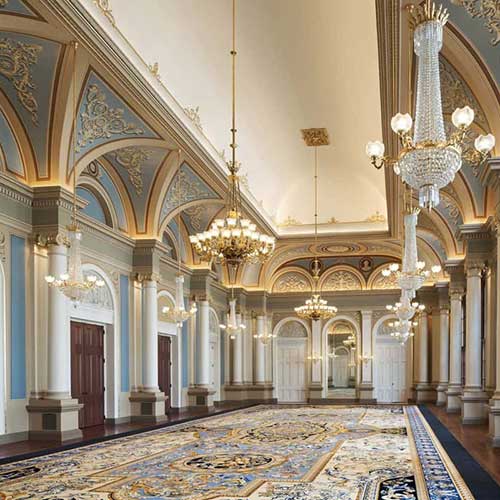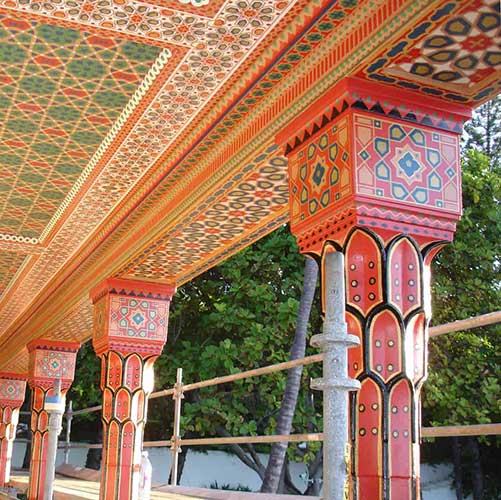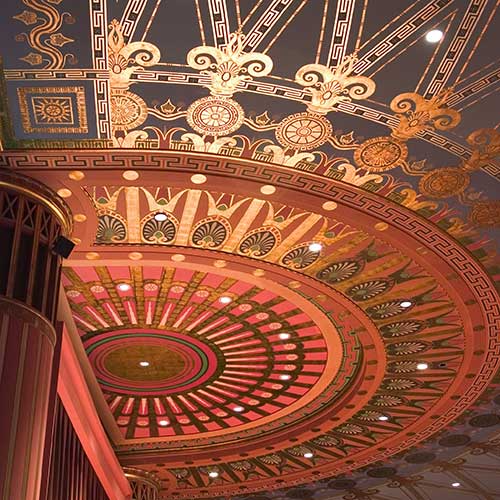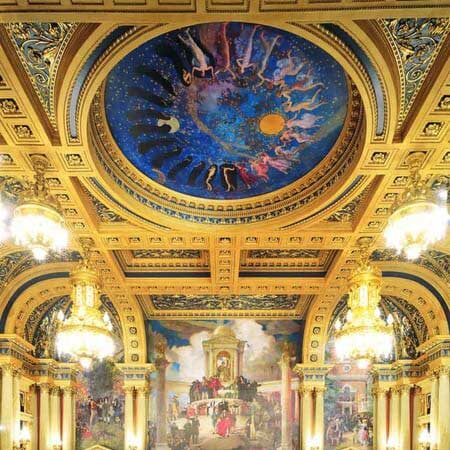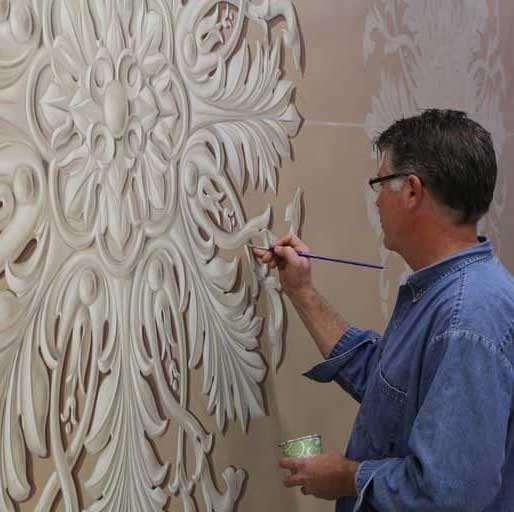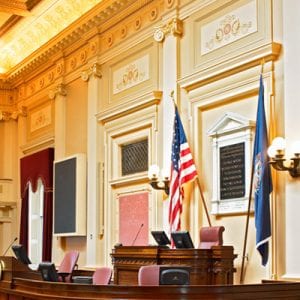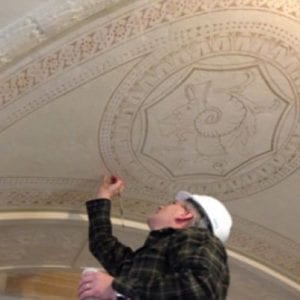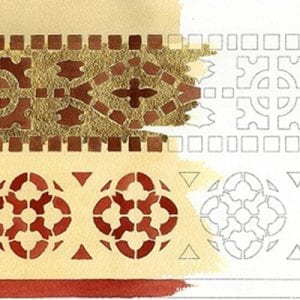Decorative Painting & Finishes Restoration Services
Restoration and creation of period-correct decoration requires the in-depth knowledge and skill that John Canning & Co. is known for.
Decorative paint and finishes are commonly found in many historic structures throughout the world. Murals, friezes, frescoes, and other decorative elements are often found in churches, courthouses, libraries, private homes; virtually any structure with a ceiling or wall has the potential to house artwork.
Unfortunately, these brilliant and unique masterpieces can become damaged or otherwise lost to the passage of time. Paint chips or peels away; finishes dull with the accumulation of soot and debris; artwork is covered over with fresh paint, which is then covered over with another coat of paint; and so on.
Often owners can be unaware that these original designs even exist in their structures until a historic paint and finishes analysis takes place and reveals the truth. At that moment, the owner, architect, and anyone else involved with the decorative painting project must determine the best path forward. What portions of the artwork can and should be conserved? What can be restored? What must be recreated from scratch? What work can be performed in the studio and what work needs to be done on-site?
As specialty decorative painting contractors, John Canning & Co. has decades of experience and expertise preserving, restoring, and recreating original historical works, and can guide you in determining the best path forward for your structure.
Our decorative painting and finishing skills include:
- Complex Stenciling
- Illusionistic Painting (Trompe L'oeil)
- Gilding
- Glazing
- Simulated Stone (Marbleizing)
- Wood Graining (Faux Bois)
- Conservation of Existing Decorative Finishes
Our knowledge of traditional materials and how they interact is also a key element when conserving existing original decoration and replicating original work. When new period design must be created, we reference past masterpieces like the 1st-century decoration of Santa Maria Maggiore Basilica in Rome and the fine detail of 19th-century Herter Brothers to ensure that the new artwork matches the historic fabric of your building.
Need an expert opinion for your project? Request a Consultation.
Our Process
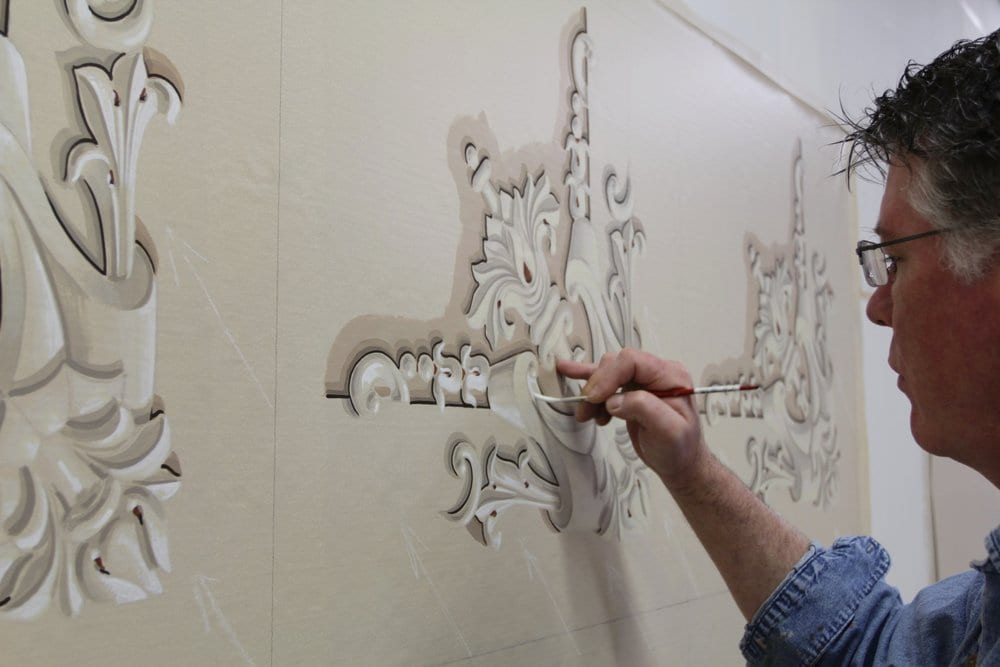
The process of preserving, restoring, and recreating decorative paint and finishes varies from project to project. That being said, certain steps (as outlined below) are fairly typical and expected of most projects.
At the beginning of each engagement, our first aim is to understand the history of the interior. This includes gathering as much information as possible about the original purpose of the building, the architect, and the style and period that the structure represents. It also involves understanding whether or not there are decorative elements elsewhere in the structure that can and should be referenced. It is not uncommon for the process to begin with a historic paint and finish investigation.
Simultaneously, we seek to understand what the owner desires from the engagement. Understanding the budget and scope of the project alongside the owner’s intentions allows us to make the best possible recommendations in terms of what can and should be preserved, restored, or recreated.
Once we have all of the required information, the next step is to create a mockup of the work, which will allow the owner and other stakeholders to better visualize the completed artwork, and represents a better understanding of how colors and design elements will interact with the existing setting.
After the mockup is complete and all parties are satisfied, final implementation can begin.
Cost Factors
The exact cost of a decorative painting and finishing project will naturally depend upon a number of factors. Some of these include:
- Whether or not the process begins with a historic paint and finishes investigation
- The size of the work
- The complexity of the work
- Required access and logistics (for example, whether the work requires scaffolding or if the building needs to incorporate public egress)
- Whether preservation of any existing components is feasible
- Special materials costs
For this reason, it is difficult for us to say what a typical quote might be. The best way to get an accurate picture of what the costs may entail is by contacting us directly.
Our Specialties
In addition to decorative painting and finishing, we specialize in a number of other complementary services, including:
Selected Projects
The Philadelphia Academy of Music restoration involved analysis of up to 16 layers of paint aggressive exposure methods to reveal faintly ghosted patterns.
We traveled to Hawaii to restore the phenomenally intricate, historic Islamic stencil decoration at Doris Duke’s Shangri La, Center for Islamic Arts and Cultures where protecting against the environmental stresses of oceanfront moisture, salt, and wind were factored into our solutions.
Our conservation team restored the interior decoration painting, architectural gilding, and plaster at Rackham Auditorium, University of Michigan.
We combined preservation research, restoration, and conservation of the original Jesuit chapel sacred design with new decoration elements designed to adapt the space for secular events and student dining.
Our team provided restoration of the plaster, decorative painting, and historic woodwork repair and refinishing at the Pennsylvania State Capitol Building.
Our team served as the prime specialty contractor and conservator for Independence Hall, researching, defining, and restoring the courtroom and entrance hall’s original historic decoration
The firm’s knowledge of historic finishes, their attention to the minute detail of every feature, the consideration they give to all documentation of original features, from historic photographs to paint sampling, and their dedication to appropriate restoration are impressive.
Canning’s thorough knowledge of period decoration and methodology, as well as traditional materials, was a valuable contribution to the project team.
Finding remnants of original decorative patterns that had been whitewashed for 75 years. [John Canning Co.] restored them to their splendor and created a beautiful worship space for the present day community.

